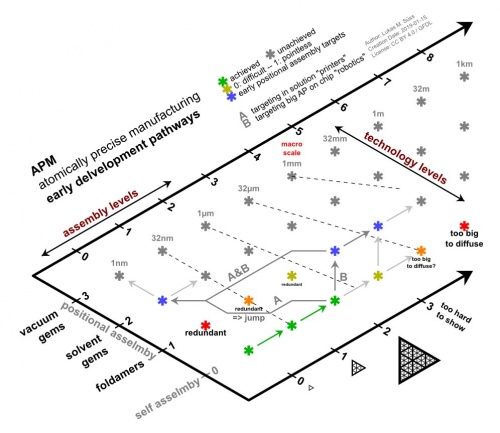Difference between revisions of "Foldamer robot approach (incremental path)"
(Basic page) |
m (Apm moved page Robo approach (incremental path) to Foldamer robot approach (incremental path): more specific) |
||
| (14 intermediate revisions by the same user not shown) | |||
| Line 1: | Line 1: | ||
{{stub}} | {{stub}} | ||
| − | [[File:APM-EarlyDevelopmentPaths.jpg|500px|thumb|right|Possible map for the incremental path.]] | + | [[File:APM-EarlyDevelopmentPaths.jpg|500px|thumb|right|Possible map for the incremental path. The [[robo approach]] corresponds to path '''B''' in the diagram.]] |
| − | This is about a possible sub-branch of the [[incremental path]]. The idea here is to scale up [[self-assembly]] capabilities of various [[foldamer]] technologies quite far (yellow or orange "too big to diffuse?" star in the diagram). And only then take a turn left in the diagram to more advanced materials. | + | This is about a possible sub-branch of the [[incremental path]]. |
| + | |||
| + | The idea here is to scale up [[self-assembly]] capabilities of various [[foldamer]] technologies quite far (yellow or orange "too big to diffuse?" star in the diagram). And only then take a turn left in the diagram to more advanced materials. | ||
| + | |||
| + | '''Path marked with B in the diagram.''' | ||
'''How would that look like in reality?''' | '''How would that look like in reality?''' | ||
| Line 9: | Line 13: | ||
There would be quite advanced bottom up-self assembled foldamer based systems on chip. <br> | There would be quite advanced bottom up-self assembled foldamer based systems on chip. <br> | ||
Perhaps so far so that | Perhaps so far so that | ||
| − | * [[bottom up positional assembly]] has already reached and | + | * [[bottom up positional assembly]] has already been reached and |
* [[top down positional assembly]] became possible. | * [[top down positional assembly]] became possible. | ||
| − | + | The robo approach in the incremental path basically entails <br> | |
| + | compared to [[diamoindoid]] low performance de-novo protein and other foldamer based productive nanosystems<br> | ||
| + | at larger but not necessarily macro-scales. | ||
| + | |||
| + | == Applications == | ||
| + | |||
| + | Potential side applications at this potential early stage of tech development.<br> | ||
| + | It seems not much comes up here. | ||
| + | |||
| + | This could e.g. make quite big structures usable for: | ||
| + | * bigger gratings for neutral atom helium matter wave microscopes | ||
| + | * much bigger optical gratings like on butterfly wings (structural color) | ||
| + | * maybe nanofluidics with chambers integrating enzymatic proteins or such? | ||
| + | * ... | ||
== Related == | == Related == | ||
| + | * Turn left here: [[Robo approach]] | ||
* Turn left earlier: [[Printer approach]] | * Turn left earlier: [[Printer approach]] | ||
* Turn left earliest: [[Catalysis construction kit approach]] | * Turn left earliest: [[Catalysis construction kit approach]] | ||
| + | ---- | ||
| + | * [[Modular molecular composite nanosystems]] | ||
---- | ---- | ||
* [[Incremental path]] | * [[Incremental path]] | ||
* [[Positional assembly]] | * [[Positional assembly]] | ||
* [[Pathways]] | * [[Pathways]] | ||
| + | * [[Positional assembly redundancy blockade]] | ||
| + | ---- | ||
| + | * '''[[Digital control over matter]]''' | ||
| + | ---- | ||
| + | * For something similar but in the context of the direct path see: <br>[[RepRec pick-and-place robots (GemGum)]] | ||
Latest revision as of 20:52, 27 June 2023

This is about a possible sub-branch of the incremental path.
The idea here is to scale up self-assembly capabilities of various foldamer technologies quite far (yellow or orange "too big to diffuse?" star in the diagram). And only then take a turn left in the diagram to more advanced materials.
Path marked with B in the diagram.
How would that look like in reality?
There would be quite advanced bottom up-self assembled foldamer based systems on chip.
Perhaps so far so that
- bottom up positional assembly has already been reached and
- top down positional assembly became possible.
The robo approach in the incremental path basically entails
compared to diamoindoid low performance de-novo protein and other foldamer based productive nanosystems
at larger but not necessarily macro-scales.
Applications
Potential side applications at this potential early stage of tech development.
It seems not much comes up here.
This could e.g. make quite big structures usable for:
- bigger gratings for neutral atom helium matter wave microscopes
- much bigger optical gratings like on butterfly wings (structural color)
- maybe nanofluidics with chambers integrating enzymatic proteins or such?
- ...
Related
- Turn left here: Robo approach
- Turn left earlier: Printer approach
- Turn left earliest: Catalysis construction kit approach
- For something similar but in the context of the direct path see:
RepRec pick-and-place robots (GemGum)